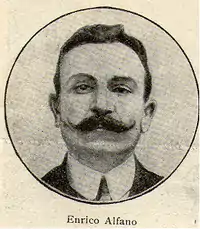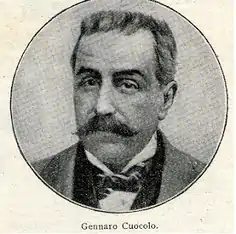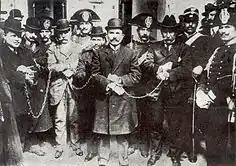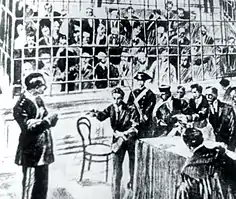Enrico Alfano
Enrico Alfano (Italian pronunciation: [enˈriːko alˈfaːno]; 1869 or 1870 – date of death unknown), also known as "Erricone", was considered to be one of the chiefs of the Camorra, a Mafia-type organisation in the region of Campania and its capital Naples in Italy, at the turn of the 20th century. He was described as "a kind of president of the confederation."[2] According to some sources, Alfano was linked to the murder of New York City police lieutenant Joseph Petrosino in Palermo in 1909, however, the murder had since been attributed to the Sicilian Mafia.
Enrico Alfano | |
|---|---|
 Camorra boss Enrico Alfano at the Cuocolo trial in Viterbo in 1911 | |
| Born | 1869 or 1870[1] |
| Died | Unknown Unknown |
| Other names | Erricone |
| Citizenship | Italian |
| Occupation | Camorra boss |
| Allegiance | Camorra |
| Criminal charge | Murder |
| Penalty | 30 years imprisonment |
Alfano was accused of being the man behind the murder of rival Camorra boss Gennaro Cuocolo and his wife. The trial against Alfano and his associates in Viterbo in 1911–12, expanded from a murder case into a tribunal against the Camorra and attracted a lot of attention of newspapers and the general public both in Italy as well as in the United States. He was sentenced to 30 years in prison in July 1912, and despite the fact that the legitimacy of the trial was seriously questioned when the main witness for the prosecution retracted, he was only released in 1934 after having served 27 years.
Early life
The son of a shoemaker,[3] Alfano began as a fruit merchant in Naples and speculating on the cattle fairs. He apparently became affiliated with the Camorra at an early age, but this is not certain because he was not mentioned in a 1901 investigation report by the Ministry of Interior[4] – known as the Saredo Inquiry since it was led by senator Giuseppe Saredo (it) – which unearthed an extensive political patronage system in the city of Naples.[5] However, the inquiry revealed little about the inner workings of the Camorra.[6] According to an informer, Alfano had become the head of the Camorra after the death of the legendary capintesta (head-in-chief) Ciccio Cappuccio in 1892,[7] although other sources disagree over his rise to power.
According to a New York Times report on the Cuocolo trial in 1911, Alfano was below medium height but a man of commanding presence; across his cheek he bore a long scar, the sfregio (a knife slash for dishonour; a sign of Camorra punishment).[4] The New York Times reported that he was arrested many times as an accomplice in homicide, robbery and less important charges, but had never been convicted.[6] According to the Italian newspaper La Stampa, Alfano did spent six or seven years in prison, where he earned his initiation as a camorrista, which gave him the "right" to demand a tangente, protection money, from the merchants in the neighbourhood he controlled.[8]
Both sources agree that Alfano imposed his position when he defeated the Camorra head, the capintesta Totonno 'o Pappagallo (The Parrot) – so-named for his beak parrot nose – in a zumpata – a kind of ritual initiation knife duel – despite the fact that his adversary sent his Mastino dog to attack Alfano.[3] The conflict started when Pappagallo returned from prison and found Alfano in control of his former territory.[8][9] Other sources mention that after the death of Cappuccio, Giuseppe Chirico, 'o Granatiere (The Grenadier), from the Porta San Gennaro neighbourhood was elected. He was defeated in a zumpata by Totonno 'o Pappagallo, who took over the reign before being defeated by Alfano around the turn of the century.[10][11]
Camorra boss
While Luigi Fucci, known as 'O Gassusaro, was the nominal head, the capintesta, of the Camorra at the time, Alfano was the actual leader and was described as "a kind of president of the confederation."[2] He had his own representative in the twelve districts next to the capintrito rionale that answered to Fucci.[3][12] He worked closely with his associate Giovanni Rapi – a former primary school teacher turned gambling operator and usurer –, who after a gambling stint in France opened the Unione del Mezzogiorno club in 1902, popular among the aristocracy.[6][13][14] Rapi and Alfano specialised in providing usury loans to merchants and gamblers, collecting extortion money, as well as procuring. He lived the good life and dressed very elegantly in Poole suits from London and Boivin shirts from Paris. He followed his rich clientele to the casinos in Nice, Montecarlo and Aix-les-Baines in the spring.[8] Even the Naples lighting company paid protection money to prevent their wires being stolen.[15]
In 1902, the famous French vaudeville singer and dancer, and the vedette of the Folies Bergère, Eugénie Fougère, who was performing at the Salone Margherita a café-chantant in Naples, contacted Alfano to get back her stolen jewelry. Within a few days, Alfano tracked the thieves and restored the jewelry. The case hit the news headlines and Alfano was arrested for complicity with the thieves but was absolved.[3]
The power of Alfano reached as far as politics. Together with his right-hand men, the priest Ciro Vitozzi and his associate Giovanni Rapi, Alfano was said to be the man behind the election in 1904 of the Count Vincenzo Ravaschieri Foschi to parliament to the detriment of the incumbent socialist deputy Ettore Ciccotti.[16][17][18][19] The night before the election dissident voters were intimidated, assaulted, beaten, and sustained knife injuries by ruffians hired and encouraged by both the Camorra and the police, since the authorities equally disapproved of a socialist candidate.[3][20] Alfano, Rapi and Vitozzi were seen and photographed while actively directing the vote in favour of Count Ravaschieri in the Camorra controlled district of Vicaria in which Ciccotti surprisingly had won in 1900. Ravaschieri won the 1904 election.[16][20][21]
Cuocolo murder

Alfano was charged with the murder of Gennaro Cuocolo and his wife, suspected of being police spies, on 6 June 1906. The murder case would develop into one of the most complicated legal cases of the early twentieth century in Italy.[22] The police moved quickly to arrest Alfano and his brother Ciro, Giovanni Rapi, and two members of the Camorra rank and file, Gennaro Jacovitti and Gennaro Ibello. They had frequented a restaurant in Torre del Greco, in the vicinity of the Cuocolo murder. However, the investigation did not produce evidence and the suspects were released from jail 50 days later, not in the least thanks to the intervention of the priest Ciro Vitozzi, the "guardian angel" of the Camorra and Erricone's god-father.[22][23][24]
On the basis of Vitozzi's declarations and the testimony of Giacomo Ascrittore, a regular police informer and member of the Camorra, the local police and judiciary of Naples identified Gaetano Amodeo and Tommaso De Angelis as the real killers.[25][26] However, the murder investigation was transferred to the Carabinieri and delegated to Captain Carlo Fabbroni. Fabbroni accused the Naples police of inefficiency and corruption. The investigation got new momentum when Gennaro Abbatemaggio, a young camorrista and a former Carabinieri informer serving a jail sentence in Naples, testified that the decision to kill Cuocolo, suspected of being a police spy, had been taken at a meeting at the restaurant chaired by Alfano.[22] The developments of the case and suspected police corruption were discussed in parliament several times.[20][27]
In New York
Meanwhile, after his release, Alfano left Naples and went from village to village to elude arrest. The Carabinieri located him in San Leucio, near Caserta, but he managed to escape.[28] He fled to Rome, obtained a false passport and sailed for the United States from Marseilles, France. He disembarked on 17 March 1907, in New York disguised as a member of the ship's crew, posing as a stoker. In New York he began to run a gambling den in the basement of 108 Mulberry Street. He became one of the primary underworld targets of police sergeant Joseph Petrosino of the New York City Police Department, who believed Alfano to be a big player in the New York branch of the Camorra.[28][29][30]
Petrosino received anonymous letters from Neapolitans in New York that confirmed Alfano's presence in the city, where he allegedly had given a banquet to several local Camorra members in a Grand Street restaurant.[6] On 17 April 1907, Petrosino and his agents raided the apartment at 108 Mulberry Street where Alfano was living and arrested him. The arrest caused a sensation in Naples.[31] He had been convicted of a crime involving moral turpitude in Italy and was turned over to the Federal authorities. Within three days he was expelled and put on a ship to Le Havre in France, where he was picked up by the Italian police.[4][6] He was put behind bars in Naples.[32] According to some sources, Alfano was linked to the lieutenant Petrosino's murder in Palermo on 12 March 1909,[6] however, had since been attributed to the Sicilian Mafia, and to Vito Cascio Ferro in particular.
Trial in Viterbo



Back in Italy, Alfano stood trial at Viterbo for the Cuocolo murders. On 27 March 1909, the Assistant Public Prosecutor committed 47 persons for trial by the Court of Assizes in Naples. However, due to many attempts to corrupt the authorities and other obstacles the trial was transferred to the Court of Assizes in Viterbo, 250 kilometres from Naples and 80 kilometres north of Rome.[22]
The often uproarious and spectacular Cuocolo trial attracted a lot of attention of newspapers and the general public both in Italy as well as in the United States, including by Pathé's Gazette.[33] The trial was transformed from a murder trial into one against the Camorra as a whole. The hearings began in the spring of 1911 and would continue for twelve months. Fabbroni intended to use the trial to strike the final blow to the Camorra.[22][23] The trial was attended by the former mayor of New York City, George B. McClellan, in whose administration Petrosino was killed.[34]
Funds to pay the defendant's lawyers were reportedly collected in Naples and from Neapolitan restaurants in New York. The amount collected was 50,000 lire, or USD 10,000, at the start of the trial. Giovanni Rapi, the Camorra's "treasurer", had an interest in a private bank in New York where the savings of immigrants were forwarded to Italy. The New York defence fund treasurer was Andrea Attanasio, also sought in connection with the Cuocolo matter.[23][32]
The trial was Captain Fabbroni's finest moment. He testified in 21 hearings and his testimony filled 285 pages.[35] He accused the police, politicians and even the judiciary of being involved with the Camorra.[36] Alfano claimed he was innocent. "I am the victim of yellow journalism," he told the judge. "I have been ruined by the Carabinieri. The story that I have been the head of the Camorra is a legend. I was neither its head nor its tail. I admit that I have committed some excesses. What youth of my social class in Naples has not?"[4]
Conviction
After a 17-month trial, the often tumultuous proceedings ended with a guilty verdict on 8 July 1912. The defendants, including 27 leading Camorra bosses, were sentenced to a total of 354 years' imprisonment. The main defendants Enrico Alfano and Giovanni Rapi were sentenced to 30 years. The priest Vitozzi received seven years and government witness Abbatemaggio five years.[22][37][38][39] The jury had been held in isolation since March 1911. The reports of the proceedings were about 40,000 pages in 63 volumes.[38] In his last statement before the verdict, a furious Alfano accused the authorities to have killed his brother Ciro, who had died in prison. Another defendant, Gennaro De Marinas, who was sentenced to 30 years as well, slashed his throat with a piece of glass in the Court when the verdict was delivered.[38][39][40]
After his conviction Alfano was transferred to the prison of Sassari, on the island of Sardinia. As The New York Times reported: "The convicts did all in their power to see the great criminal and pay him a kind of court, putting themselves at his disposition as subjects would to a sovereign."[41] Many fan letters addressed to him arrived at the penitentiary, including love letters from women.[41] In prison he took up the old family trade of shoemaking.[42]
Release
In 1927, fifteen years later, government witness Gennaro Abbatemaggio withdrew his accusations.[22] However, despite serious doubts of several magistrates about the legitimacy of the trial, the case was never reopened.[43] Abbatemaggio had invented everything about a crime of which he knew nothing. Captain Fabbroni had spent 350,000 lire to pay the witnesses, according to Abbatemaggio,[40][44] and he described the case as "a setup against the leaders of the Neapolitan Camorra organized by him in accordance with the collaborators of Captain Fabbroni."[45]
In 1930, a request for pardon was made by the Neapolitan newspaper Il Mattino, which at the time of the trial had strongly supported the work of the police. Alfano's sister, Rosina Alfano, tried to convince the suspected real killer Gaetano Amodeo – who privately admitted to have been the slayer and had been identified as such by the first inquiry of the Naples police – to publicly confess the murder, which he refused to do.[46] In subsequent years, the requests for pardon came before Benito Mussolini one by one. In his own hand the Duce wrote on those instances: "Provisions should be individually, ranging measures over time."[44] Alfano was granted a conditional release for good behaviour on 16 October 1934, after serving 27 years of his sentence.[47] The erstwhile head of the Camorra vanished into oblivion.
In popular culture
- Forgione, Louis (1928). The Men of Silence, New York, E. P. Dutton. The book is a novelization of the Cuocolo murder and trial based on the trial records, with a foreword by Walter Littlefield, the New York Times correspondent who had reported on the case.[48]
- The City Stands Trial (Italian: Processo alla città), a 1952 Italian drama film directed by Luigi Zampa and starring Amedeo Nazzari is based on a revisiting of the Cuocolo murders and the struggle for control of Naples by the Camorra in the early 1900s.[49]
References
- Notes
- He was reported to be 64 when he was released in 1934, see: La liberazione condizionale concessa a uno dei mandanti nel processo Cuocolo, La Stampa, October 18, 1934
- Critchley, The Origin of Organized Crime in America, p. 120
- Paliotti, Storia della Camorra, pp. 191–98
- Alfano Holds Stage at Viterbo Assizes, The New York Times, April 1, 1911
- Dickie, Blood Brotherhoods, p. 184–86
- Criminal Band That Murdered Petrosino In Police Coils, by Walter Littlefield, The New York Times, September 11, 1910
- Camorrist Told All To Win His Bride, The New York Times, March 6, 1911
- (in Italian) Erricone, l'assassino dei coniugi Cuocolo, La Stampa, June 7, 1907
- A fictional account of the zumpata is told by Italian-American author Louis Forgione in The Men of Silence, see under In popular culture.
- (in Italian) Consiglio, La camorra a Napoli, p. 124
- (in Italian) Paliotti, Storia della Camorra, pp. 175–80
- Di Fiore, Potere camorrista, p. 111
- French Detective at Viterbo Trial, The New York Times, May 27, 1911
- An American Lawyer at the Camorra Trial, by Arthur Train, McClure's Magazine, November 1911, pp. 71-82
- Says Business Paid Tribute To Camorra, The New York Times, July 12, 1911
- Says Politicians Hire The Camorra, The New York Times, July 13, 1911
- (in Italian) I mille spettri della camorra, La Stampa, April 3, 1982
- Di Fiore, Potere camorrista, p. 117
- (in Italian) Serena Robba (2009). Camorra - uno stile di vita, Tesi di Laurea, Università degli Studi del Piemonte Orientale "Amedeo Avogadro"
- (in Italian) Atti Parlamentari 17 giugno 1907, Camera dei Deputati
- (in Italian) Paliotti, Storia della Camorra, p. 186
- The Cuocolo trial: the Camorra in the dock, Museo criminologico (Retrieved May 25, 2011)
- Cuocolo Trial May Be Death Blow of the Camorra, The New York Times, March 5, 1911
- Don Ciro Vitozzi's Tears Move Court, The New York Times, April 7, 1911
- Ascrittore Again Heard At Viterbo, The New York Times, April 12, 1911
- Ex-Ministers At Trial.; One of Them, Signor Riccio, Mentioned by Sortino in His Defense, The New York Times, May 21, 1911
- (in Italian) I rapporti fra camorra e polizia in Napoli discussi a la Camera, Corriere della Sera, April 2, 1908
- Camorra Chief's Flight; Alfano Reached America After Many Adventures In Italy, The New York Times, April 22, 1907
- Romano, Italian Americans in Law Enforcement, p. 45
- Petacco, Joe Petrosino, p. 83
- Camorra's Chief Caught, The New York Times, April 20, 1907
- Critchley, The Origin of Organized Crime in America, pp. 106–07
- Dickie, Blood Brotherhoods, p. 191
- Ex-Mayor McClellan At Camorra Trial, The New York Times, May 3, 1911
- Di Fiore, Potere camorrista, p.123
- Dickie, Blood Brotherhoods, p. 210
- Behan, The Camorra, p. 23
- Camorrist Leaders Get 30-Year Terms, The New York Times, July 9, 1912
- Camorra Verdict; All Found Guilty, New York Tribune, July 9, 1912
- (in Italian) Paliotti, Storia della Camorra, pp. 210-14
- Court The Camorra Chief, The New York Times, November 10, 1912
- (in Italian) Il dramma che risorge dopo 18 anni, La Stampa, June 18, 1930
- (in Italian) Preoccupazioni e dubbi di magistrati nell'affare Cuocolo, La Stampa, June 22, 1930
- (in Italian) Napoli tra le due guerre, Atti del Convegno di Studi Storici tenutosi a Napoli il 28 febbraio 2008, Istituto di Studi Storici Economici e Sociali, Napoli, p. 19
- Di Fiore, Potere camorrista, p.122
- (in Italian) Amodeo è stato sul punto di confessare pubblicamente, La Stampa, June 22, 1930
- (in Italian) La liberazione condizionale concessa a uno dei mandanti nel processo Cuocolo, La Stampa, October 18, 1934
- Thomas J. Ferraro, Italian American Literature, in: Parini, The Oxford Encyclopedia of American Literature, p. 277
- Moliterno, The A to Z of Italian Cinema, p. 342
- Sources
- Behan, Tom (1996). The Camorra, London: Routledge, ISBN 0-415-09987-0
- (in Italian) Consiglio, Alberto (2005). La camorra a Napoli, Naples: Guida Editori, ISBN 88-7188-917-7
- Critchley, David (2009). The Origin of Organized Crime in America: The New York City Mafia, 1891–1931, New York: Routledge, ISBN 0-415-99030-0
- Dickie, John (2014). Blood Brotherhoods: Italy and the Rise of Three Mafias, New York: PublicAffairs, ISBN 978-1-61039-428-4
- (in Italian) Di Fiore, Gigi (1993). Potere camorrista: quattro secoli di malanapoli, Naples: Guida Editori, ISBN 88-7188-084-6
- Moliterno, Gino (2008). The A to Z of Italian Cinema, Plymouth: Scarecrow Press ISBN 978-0-8108-7059-8
- (in Italian) Paliotti, Vittorio (2006). Storia della Camorra, Rome: Newton Compton editore, ISBN 88-541-0713-1
- Parini, Jay (ed.) (2003). The Oxford Encyclopedia of American Literature, Oxford University Press,
- (in Italian) Petacco, Arrigo (1972/2001). Joe Petrosino: l'uomo che sfidò per primo la mafia italoamericana, Milan: Mondadori, ISBN 88-04-49390-9 (originally published in 1972)
- Romano, Anne T. (2010). Italian Americans in Law Enforcement, Xlibris Corporation, ISBN 978-1-4535-5881-2